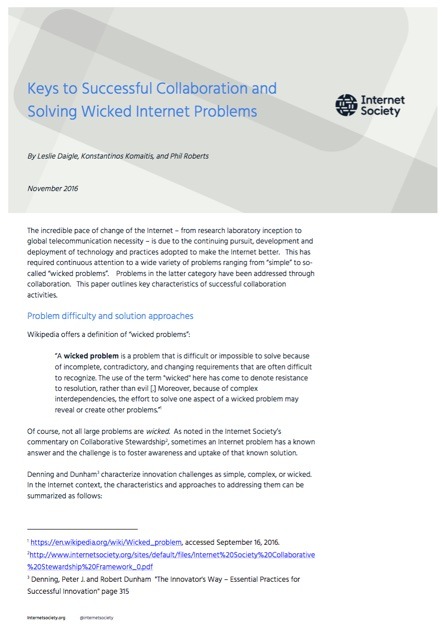The incredible pace of change of the Internet – from research laboratory inception to global telecommunication necessity – is due to the continuing pursuit, development and deployment of technology and practices adopted to make the Internet better. This has required continuous attention to a wide variety of problems ranging from “simple” to so-called “wicked problems”. Problems in the latter category have been addressed through collaboration. This paper outlines key characteristics of successful collaboration activities.
Problem difficulty and solution approaches
Wikipedia offers a definition of “wicked problems”:
“A wicked problem is a problem that is difficult or impossible to solve because of incomplete, contradictory, and changing requirements that are often difficult to recognize. The use of the term “wicked” here has come to denote resistance to resolution, rather than evil [.] Moreover, because of complex interdependencies, the effort to solve one aspect of a wicked problem may reveal or create other problems.”[1]
Of course, not all large problems are wicked. As noted in the Internet Society’s commentary on Collaborative Stewardship[2], sometimes an Internet problem has a known answer and the challenge is to foster awareness and uptake of that known solution.
Denning and Dunham[3] characterize innovation challenges as simple, complex, or wicked. In the Internet context, the characteristics and approaches to addressing them can be summarized as follows:
|
Type |
Characteristics |
Solution path |
|
Simple |
Solutions, or design approaches for solutions, are known |
Cooperation: Awareness-raising and information sharing – typically through Network Operator Groups |
|
Complex |
No known solution exists, the problem spans multiple parts of the Internet |
Consensus: Open, consensus-based standards development |
|
Wicked |
No solution exists in any domain, general lack of agreement on existence or characterization of the problem |
Collaboration: moving beyond existing domain and organization boundaries and set processes for determining problems and solutions |
Why Internet problems are often wicked
First, it is important to understand that, today, the Internet is largely composed of private networks. Individual participants, corporations or otherwise, must have a valid business reason for the adoption of a certain technology or practice in their own network. This does not necessarily rise to the level of a quantifiable business case, but they have to have some valid reason that it helps them make something better in their own networks or experience of the Internet.
However, if the practice is a behavior on the network that is impacted by, or includes other networks, the participants must have a standard they agree to. This might be a protocol standard governing bits on the wire and the exchange of communication, or a common practice.
To get to that level of agreement, participants – whether private companies with financial stakes in the situation, or governments, or individuals – must be disposed and willing to collaborate with others to instantiate the adoption.
Addressing wicked Internet problems: Keys to successful collaboration
We identify here four important characteristics of collaborative activities that have driven the success and innovation of the Internet to date.
- There must be a unifying purpose. There can be any number of participants in a successful collaboration, and they can have a range of different perspectives on what a good outcome looks like, but the participants must be united in their desire for an outcome. The participants will have some shared sense of “good.” It is likely that that sense of “good” will include something about collaboration itself. That is to say, the very act of collaborating to achieve an outcome will yield a better outcome than some other method.
- Involved participants are committed and focused. The experience of successful collaboration includes skillful contributions that move discussions and actions forward towards a desired outcome. These contributions are regular, consistent, and timely. In such an environment, distractions are discouraged. In order to move the work forward, exploring alternatives is necessary, but willful distractions are not acceptable.
- Forward action requires crossing boundaries and changing practices: Collaboration is more than the cooperation of individuals or organizations contributing their existing expertise. It ultimately requires action that reaches beyond traditional boundaries and/or creation of new processes. Competitors cooperate. New ground is explored.
- A successful outcome is measured in terms that are broader than individual gain. There is a desired “good” toward which people are collaborating. That “good” can be something grand and exciting for everyone, or can be some outcome that is the “least bad.” Yet, this is measured across a broad range of participants, rather than from the point-of-view of any single individual. Participants accept that the outcome may not reflect any immediate advances for their own activities.
Conclusion
The Internet has a long history of successful innovation through broad-based collaboration. As the Internet has grown continuing the same kind of collaboration has become more challenging. And yet, innovation happens, and collaboration continues. But, while invention of new technologies is often a key part of innovation, sometimes it is about practice, and in all cases it includes widespread use of technology and practice in the broad Internet community.
This only comes through collaboration and those characteristics that can ensure building a better Internet.
[1] https://en.wikipedia.org/wiki/Wicked_problem, accessed September 16, 2016.
[2] https://www.internetsociety.org/wp-content/uploads/2021/01/Internet-Society-Collaborative-Stewardship-Framework_0.pdf
[3] Denning, Peter J. and Robert Dunham “The Innovator’s Way – Essential Practices for Successful Innovation” page 315
